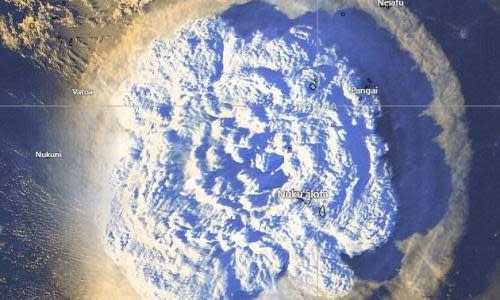Australia offers assistance to tsunami-hit Tonga after undersea volcano eruption

Australia has pledged to send humanitarian and technical assistance to Tonga in the wake of the tsunami that struck the country after a nearby underwater.
The minister for the Pacific, Zed Seselja, said Australians and officials living in Tonga had all been accounted for, but it was a rapidly unfolding situation.
“We have no particular concerns about Australians at this stage … that’s subject to some communications difficulties,” Seseja told reporters in Canberra on Sunday.
He said prime minister Scott Morrison had spoken with his New Zealand counterpart Jacinda Ardern earlier on Sunday to put in place a coordinated response.
Related: Tsunami hits Tonga after underwater volcanic eruption
He said both countries were sending surveillance aircraft to help gather as much information as possible on the situation.
Australia was aiming to send its plane on Monday to reach Tongan airspace by 9am.
“This is subject to weather conditions, particularly issues around the ash cloud. There are no guarantee we will be taking off tomorrow morning,” the minister said.
Australia was also preparing to provide humanitarian assistance though a flight from Brisbane which should be ready to go on Monday, but again subject to flight conditions and the ability to get on the ground.
The Bureau of Meteorology said the Hunga Tonga-Hunga Ha’apai volcano erupted at 3.10pm AEDT on Saturday, and tsunami waves have been observed as a result of the eruption.
The eruption – captured in satellite images that show a huge plume of ash, steam and gas rising from the ocean – was heard and felt as far away as in Fiji and Vanuatu, where people reported feeling the ground and buildings shaking for hours.
There were no immediate reports of injuries or the extent of the damage in Tonga, but online videos showed huge waves in coastal areas, swirling around homes and buildings.
Beaches on Australia’s east coast were closed Sunday morning due to the tsunami warning.
The warning for Queensland, Victoria and Tasmania beaches was lifted late on Sunday morning, but swimmers were urged to take caution.
All beaches were closed to swimmers in NSW, where the warning remains in place, according to the bureau’s latest advice.
The bureau said impacts of the tsunami were detected on Saturday at Lord Howe Island, where unusual currents and waves were observed at Ned’s Beach, and about 45 minutes later in the River Derwent in Hobart, where a half-metre tidal surge was recorded in the marina.

Land warnings were issued earlier for Norfolk Island and Lord Howe Island, however by 10.30am on Sunday these were downgraded to marine warnings.
“In areas with a threat to the marine environment only, emergency authorities advise people to get out of the water and move away from the immediate water’s edge of harbours, coastal estuaries, rock platforms and beaches,” the bureau said in a statement.
BoM meteorologist Sarah Scully said these warnings would remain in place until there were “no significant observations for six hours”.
“We’re waiting to be really sure that the impacts and the energy from the volcanic eruption has dispersed and it’s no longer a danger to any people out of the water,” she told ABC News.
Earlier, the NSW premier, Dominic Perrottet, urged people to follow the rules on Sunday, saying the beaches would remain closed until the state received updated information from the BoM.
“These rules are in place to protect you and to keep you safe,” he said.

 Yahoo News
Yahoo News 
